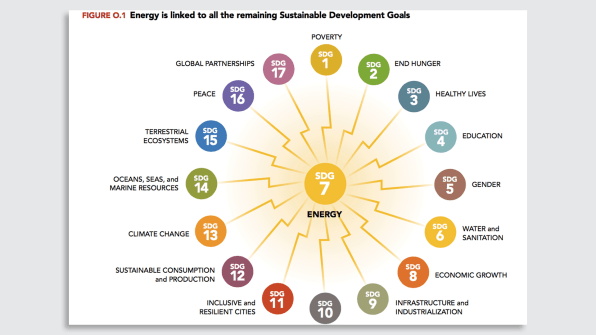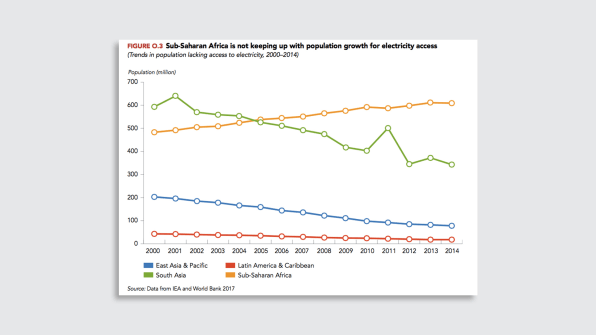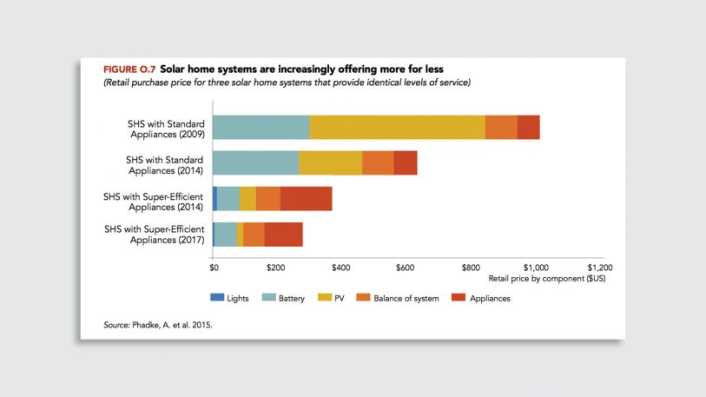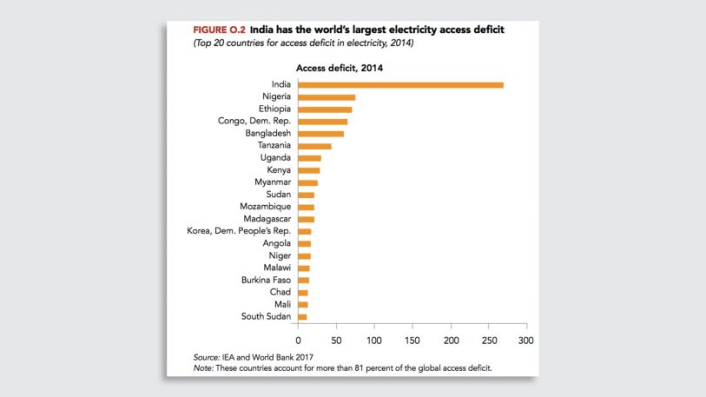A few years ago, Bill Gates annoyed some people in the renewables industry by saying that solar and wind were effectively expensive luxuries that only richer countries could afford. In the developing world, he said, dirtier forms of power might have to take priority, even if it meant exacerbating climate change (especially as most emissions come from advanced economies anyway). Expanding energy access was too important to worry about exactly what form that access might take.
In mid-2017, that dilemma–between electricity access and climate change–is starting to look like a false one. Prices for solar and wind are coming down dramatically, putting such technologies within reach of some of the poorest people in the world. At the same time, basic household lighting and appliances are growing more efficient, meaning the same small solar systems are gaining in usefulness.

“That tension that was definitely there a few years ago has dissipated and people are seeing [renewables] as a positive opportunity,” says Vivien Foster, an energy economist at the World Bank, in an interview with Fast Company. “The cost of clean energy has come down so much that it no longer looks unaffordable and more like commonplace self-interest.” She says a 40 watt home solar system that five years ago would have powered a lightbulb and charged only a phone can today run three lightbulbs, a phone charger, a radio, a small TV, and a digital fan. The cost of a home solar panel system, plus battery and standard appliances (like a TV, radio, fan) has fallen by up to three-quarters since 2009, World Bank statistics show.
That’s not to say the energy access challenge isn’t still immense. The bank’s latest report shows that 1.06 billion people (about 15% of humanity) still lack access to grid power. Though the figures are somewhat ambiguous–they don’t account for forms of distributed power, like small diesel generation or home solar–it’s clear that electrification is far behind where it was supposed to be by now. At current rates, the bank doesn’t see countries meeting Sustainable Development Goal 7, which calls for universal electricity access by 2030. It forecasts only 91% of the world with grid power by then–a deficit of approximately 750 million people. India alone still has more than 250 million without reliable electricity.
Extending electricity grids is expensive, and low-income families who use little power are not the most attractive customers. Micro-grids that localize supply and demand are more scalable, says Foster, while pay-as-you-go solar systems–where households pay off the cost through mobile payments–offer independence from the grid altogether. “As you get into rural areas, off-grid technologies now have quite a strong cost advantage and increasingly they’re providing more quality of service,” Foster says. “People used to think solar was a basic service. But with the declining cost and the higher efficiency of light bulbs and other appliances, you can actually get quite a reasonable level of service through a modestly-sized system.”

Foster points to East African countries like Kenya, Rwanda, Tanzania, and Uganda as examples for the rest of the developing world to follow. Each has a national plan embracing clean energy as a way of filling in grid access and has encouraged startups to set up businesses targeting underpowered populations. Well-funded groups like Off Grid Electric, Mobisol and M-Kopa have since expanded aggressively through the region. “Governments have to think about the full spectrum of electrification options and don’t only think about the grid,” Foster says. “They can lay the groundwork for these off-grid technologies to help accelerate the pace countries can electrify.”
That includes creating spatial maps according to population density, effectively demarcating markets for companies to operate in. Urban centers are normally most financially viable for grid expansion, while dispersed rural areas are more suitable for fully off-grid options. Micro-grids–which combine several generation types and can be as small as 10 homes or encompass whole villages with tens of thousands of people–can take up the slack in the middle. “There are plenty of examples of small-scale private companies coming in to provide mini-grids or solar home systems and then two years later the government shows up with a subsidized grid extension, and their investments are stranded,” Foster says.
At the same time, she recommends government deregulate prices (some countries force off-grid operators to charge the same as for grid electricity) and to set minimum standards for clean energy hardware, so as to build confidence in its reliability. The report argues that energy access is a foundational human need and that many of the other Sustainable Development Goals flow from it, including improving health and education in poor communities. For perhaps the first time, it’s now possible to get electricity to everyone at a price they can afford, thus spreading many associated humanitarian benefits.
Electrifying the entire world is an important part of the Sustainable Development Goals. Recent advances in renewable energy and microgrids means that it might be possible to do it quickly–and cleanly.
A few years ago, Bill Gates annoyed some people in the renewables industry by saying that solar and wind were effectively expensive luxuries that only richer countries could afford. In the developing world, he said, dirtier forms of power might have to take priority, even if it meant exacerbating climate change (especially as most emissions come from advanced economies anyway). Expanding energy access was too important to worry about exactly what form that access might take.

Solar is becoming more powerful and effective.

And many people throughout the developing world lack electricity.

It’s a problem we’ll need to solve to hit any of the Sustainable Development Goals.

But at the current rate, we’ll never get there.

Hopefully, solar and microgrids can change the trajectory.
Fast Company , Read Full Story
(41)